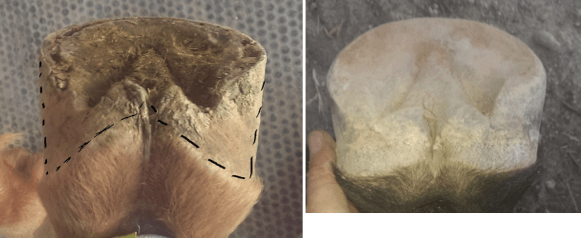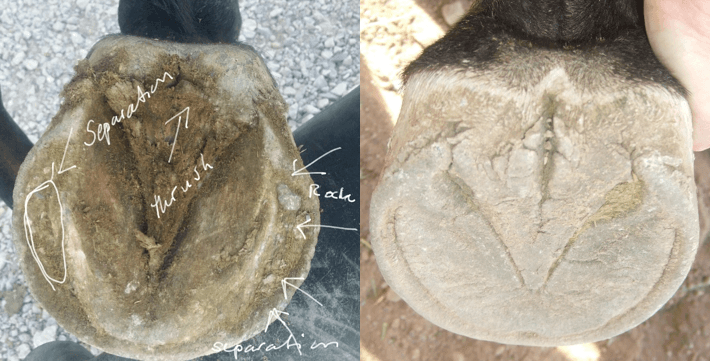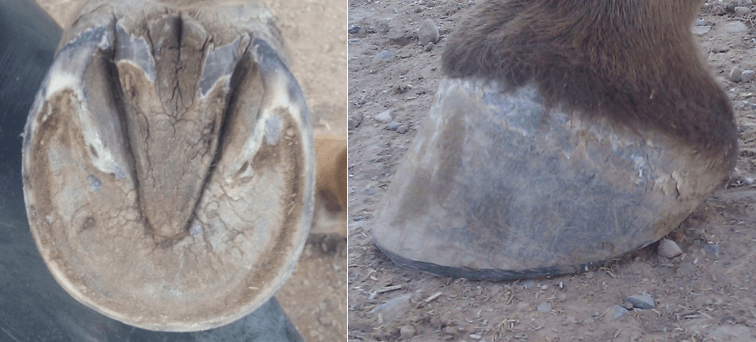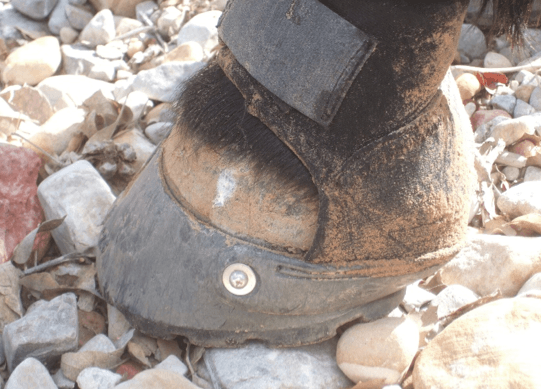Submitted by Asa Stephens, Hoof Care Practitioner
Here are a few hints that will tell you that you do.
In desert environments and in places where horses are stalled in small enclosures, you rarely get a horse that can handle sharp gravel on a trail ride.

A healthy hoof is short and has most of the bulk in the back part of the foot. It has a flat, dry, large frog. This frog rarely sheds and has no bacteria pockets.

A frog that gets paired away or is shedding at every trim or almost every trim, or has bacteria pockets in it, is not healthy and you should ride in boots.
A healthy sole will callous nicely. Dead shedding sole material does not accumulate in a healthy hoof. If this happens between each trim, the foot is not healthy. Ride in boots.

The bars are hoof wall that turns in alongside the frog and collateral grooves. They help stabilize the back of the foot. They are short and grow only halfway down the frog. If they grow out over the entire bottom of the foot between each trim, then the foot is not healthy. Ride in boots.

When you pick the foot up and look out over the heels and the hairline, you want to see thick hoof wall forming the heels and bars. They do not taper out and get thinner. The hairline should be pretty straight over the heels. If the hairline and heel bulbs form a W, the hoof is not healthy. Ride in boots.

A healthy foot will have air-tight seams between hoof wall and sole. An unhealthy hoof does not. It has separation where little gravel and dirt gets in. Because of the dry environment, the dead sole will often dry up and curl inward, making the separation worse. In the desert area, the sole has the same color as the sand and dirt so most people do not know this separation exists. The dirt is so packed in between hoof wall and sole, so you can’t see it. You will have to take a very sharp hoof pick and dig in the white line area to find it. If your horse has this separation, ride in boots. If your horse is not tender on gravel just before he is due for a trim but always after, then ride in boots.

A healthy foot should not feel a maintenance trim. When using boots while riding you ensure a healthy heel first landing which will help the horse grow the healthiest foot he can get in his situation. Adding a pad to the boot is even better as it stimulates the frog each step.
Does your horse land heel first or at least flat at a walk? This can be hard to see and if it is difficult, look for a forward motion with no hesitation, with very little dust in front of the hoof when landing. Check that the fetlock is at its lowest before landing (not coming down after hoof is on the ground). If he doesn’t land flat or heel first, ride in boots.

A little misleading. The picture on the left is a toe first landing at a walk. The picture on the right is a heel first at a trot.
A farrier does not trim or sculpt a healthy foot. The correct diet, exercise and the right environment build healthy hooves, and a good farrier maintains them. There are many variations of unhealthy feet.

Some are unfortunately permanent, if internal structures are too damaged. Some can rehab quite nicely. Some are inherently stronger (some breed of horses have an advantage because of thick hoof wall and massive frogs). They can sometimes go completely barefooted even with lack of sound “housekeeping”.

Remember, it is the internal structures that need strengthening, not so much the outer shell. By making your horse run around landing toe first battling the gravel in order to “toughen up his feet”, you most likely will never get the healthy feet you and your horse were hoping for. You are only hurting your horse.
There are many boots on the market, and if you have patience you will find the right one. Try to be there when the farrier comes to trim if and when you need boot help. The farrier would love to help you find the right boots. If you are in any of the situations mentioned above and don’t want to use the boots, you can either try glue on shoes or shells, or go back to traditional shoeing.

So if you can’t fulfill all the necessary requirements for healthy feet (most boarding facilities in Nevada have few options for 24/7 turnout), the boots are an excellent way of protecting your horse’s hooves while riding. The boots will not cause damage. They let the hooves work the way nature intended. They can be taken off after the ride when the horse goes back to his stall.
If you think boots on a horse is a sign of failure, then I have truly failed you as a hoof care provider. Try to see boots as today’s hoof protection in a sometimes imperfect situation: a way to have the cake and eat it too. Your horse’s hooves will continue improving while you ride and have fun.





